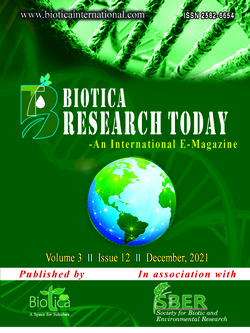
Nano-Biosensors: Applications in Agriculture and Allied Fields
Ajoy Saha
ICAR-CIFRI, Regional Centre, Bengaluru, Karnataka (560 089), India
Debarati Bhaduri*
ICAR-NRRI, Cuttack, Odisha (753 006), India
DOI: NIL
Keywords: Gen-next technology, Nanosensor, Pollution abatement, Real-time monitoring
Abstract
Nano-biosensor is the modified version of biosensor which uses nanomaterials i.e., nanoparticles and nanostructures. Because of unique physicochemical properties of nanomaterials, nano-biosensor is highly selective, sensitive, stable, and accurate and can be used for in-situ real time monitoring for need-driven purposes. This technology enables us to detect the pesticides, metals, toxins and plant metabolites at a very low concentration. Nano-based sensor technology has a lot of scope in sustainable agriculture because it may help to monitor and develop smart delivery system for fertilizer and plant protection chemicals which releases the inputs in a controlled manner. This technology can also be used in livestock and fisheries sector for real time quality and safety monitoring. However, their use is still confined at laboratory and research level. So, policy intervention is required for their mass recommendation at field level and commercial utilization.
Downloads
not found
Reference
Fang, Y., Umasankar, Y., Ramasamy, R.P., 2016. A novel bi-enzyme electrochemical biosensor for selective and sensitive determination of methyl salicylate. Biosensors and Bioelectronics 81, 39-45.
Haddaoui, M., Raouafi, N., 2015. Chlortoluron-induced enzymatic activity inhibition in tyrosinase/ZnO NPs/SPCE biosensor for the detection of ppb levels of herbicide. Sensors and Actuators B: Chemical 219, 171-178.
Shi, H., Zhao, G., Liu, M., Fan, L., Cao, T., 2013. Aptamer-based colorimetric sensing of acetamiprid in soil samples: sensitivity, selectivity and mechanism. Journal of Hazardous Materials 260, 754-761.
Zheng, Z., Zhou, Y., Li, X., Liu, S., Tang, Z., 2011. Highly-sensitive organophosphorous pesticide biosensors based on nanostructured films of acetylcholinesterase and CdTe quantum dots. Biosensors and Bioelectronics 26(6), 3081-3085.
Zhou, L., Zhang, X., Ma, L., Gao, J., Jiang, Y., 2017. Acetylcholinesterase/chitosan-transition metal carbides nanocomposites-based biosensor for the organophosphate pesticides detection. Biochemical Engineering Journal 128, 243-249.
